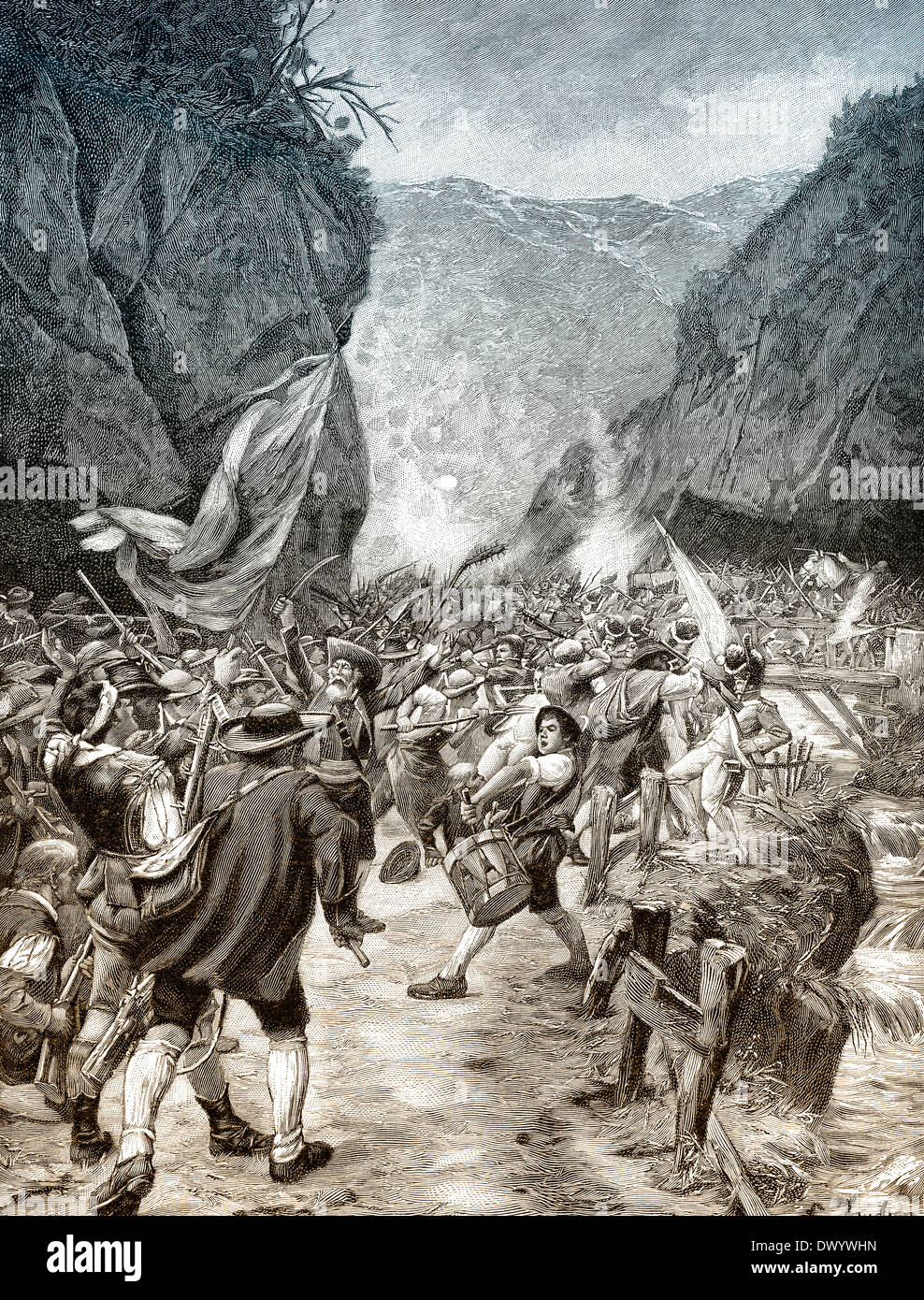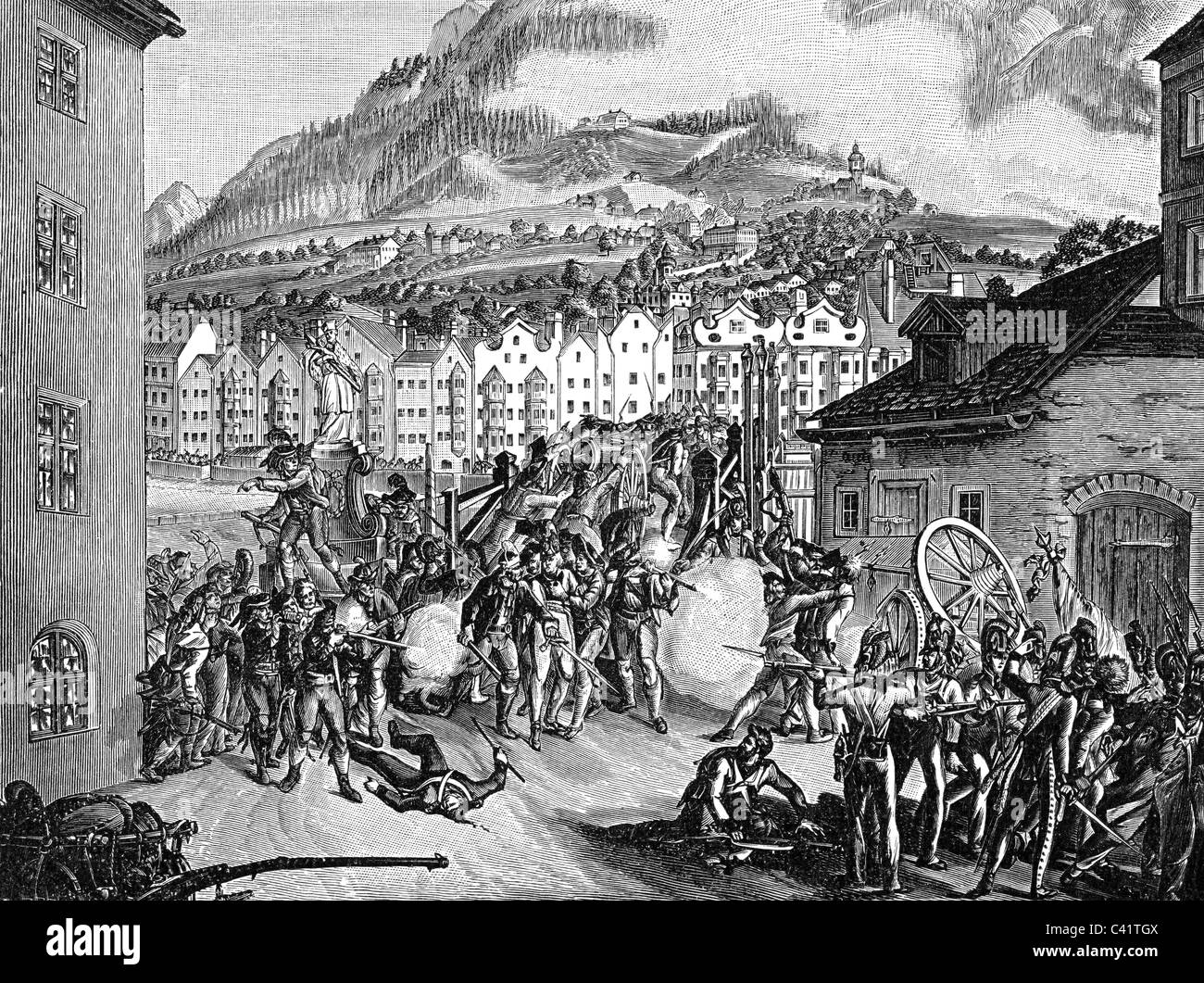Discover: Tyrol Rebellion & Bergisel Battles A Deep Dive
Could a peasant uprising, fueled by a desire for freedom, truly stand against the might of Napoleon's armies? The Tyrolean Rebellion of 1809 proves that even in the face of overwhelming odds, the human spirit, ignited by the flame of autonomy, can forge a formidable resistance.
The echoes of the Napoleonic Wars resonate through the valleys and mountains of Tyrol, a region that witnessed a fierce struggle for independence. This was not a clash of grand armies on vast plains, but a brutal, intimate conflict fought in the rugged terrain of the Alps. The Tyrolean Rebellion, also known by its German name, "Tiroler Volksaufstand," was a desperate fight against the occupation of their homeland by the French and Bavarian forces, all within the turbulent context of the War of the Fifth Coalition against Napoleon I. This was a fight for freedom and autonomy in the early 19th century, led by figures like Andreas Hofer and Joseph Speckbacher, shaped by key battles like the Battle of Bergisel.
The heart of this resistance beat in the battles of Bergisel, particularly around the strategic city of Innsbruck. Four major engagements took place on the Bergisel hill, witnessing the clash between Tyrolean civilian militiamen, supported by some Austrian government troops, and the combined military might of Napoleon's France and the Kingdom of Bavaria. The first and second battles, fought on April 12th and May 25th, saw the Tyrolean forces triumph over the Bavarians, forcing them to retreat. These victories were crucial in galvanizing the rebellion and showcasing the resolve of the Tyrolean people. The irregular Tyrolean forces, a mix of farmers, hunters, and local militia, proved surprisingly effective against the more disciplined, professional armies of the invaders.
The events of 1809 were shaped by the aftermath of Napoleon's victories. Following defeat by Napoleon in 1805, Austria was forced to cede Tyrol to the Kingdom of Bavaria in the Peace of Pressburg. Tyrol, as a part of Bavaria, subsequently became a member of the Confederation of the Rhine in 1806. This shift in power resulted in the introduction of far-reaching economic, religious, and administrative reforms by King Maximilian I of Bavaria, measures that were often resented by the Tyrolean population, who sought to preserve their traditional way of life and regional autonomy. The imposition of Bavarian rule and the French influence that came with it ignited a sense of nationalistic fervor, eventually culminating in the uprising.
The War of the Fifth Coalition, which encompassed the Tyrolean Rebellion, was a major European conflict in 1809, part of the larger Napoleonic Wars and the broader Coalition Wars. The principal conflict took place in Central Europe, pitting the Austrian Empire under Francis I against Napoleon's French Empire. Austria's attempt to challenge Napoleon's dominance in Europe offered an opportunity for the Tyroleans to strike a blow for their own freedom. While the main battles were fought elsewhere in Europe, the Tyrolean uprising tied down significant French and Bavarian resources, contributing to Napoleon's strategic challenges.
One of the key figures of the Tyrolean Rebellion was Andreas Hofer. This Tyrolean innkeeper and patriot emerged as the leader of the revolt. His tactical skills, combined with his charisma, rallied the Tyrolean people. He became a symbol of resistance, inspiring his countrymen to take up arms and fight for their freedom. Another notable figure was Joseph Speckbacher, a skilled marksman and guerilla warfare expert. Speckbacher's knowledge of the terrain and his effective tactics significantly harassed the occupying forces. Together, Hofer and Speckbacher provided both leadership and military expertise, giving the uprising its teeth.
The Tyrolean forces, predominantly comprised of irregulars, faced the challenge of a regular army. These Bavarian, French, and sometimes Italian troops possessed superior training, equipment, and strategic advantages. Yet, the Tyrolean fighters compensated for their lack of military experience with their deep understanding of the mountainous terrain, their tenacity, and their unwavering determination to defend their homeland. The battles were often characterized by ambushes, skirmishes in the dense forests, and fierce hand-to-hand combat.
The battles of Bergisel, near Innsbruck, played a pivotal role. The location itself, a strategic hill overlooking the city, became a battleground for pivotal confrontations. The Tyroleans utilized the terrain to their advantage, turning the slopes into fortresses. The outcome of these battles greatly influenced the outcome of the conflict. The victories at Bergisel initially drove the Bavarians from the region, providing a significant morale boost and fueling the hope of independence. The recapture of Innsbruck and the expulsion of the Bavarians by Hofer further solidified the success of the uprising.
In the broader context of the Napoleonic Wars, the Tyrolean Rebellion was a thorn in Napoleons side. Although it was ultimately suppressed, it diverted military resources and drew attention to the discontent brewing in areas under French influence. This small rebellion served as a testament to the enduring power of the human will and the fierce longing for freedom, even amidst the era of grand strategy and overwhelming power. The conflict highlights the complexities of the Napoleonic era, demonstrating that resistance could arise from the unlikeliest of places and influence the tide of war.
The impact of the rebellion reverberates even today. It is considered a significant chapter in Tyrolean history and a symbol of regional identity and self-determination. The events are remembered and commemorated each year, ensuring that the bravery and sacrifice of the Tyrolean people are never forgotten. It serves as a historical case study for the success of irregular forces against much better equipped regular armies.
For those interested in further exploring this fascinating historical event, numerous resources are available. Historians have documented the events, offering in-depth analysis of the military campaigns, the social dynamics, and the political motivations of the players involved. Libraries and archives house original documents, letters, and maps. There are also numerous websites, online databases, and academic publications containing primary and secondary source material.
The story of the Tyrolean Rebellion offers a valuable lesson. It speaks to the idea that even the most powerful empires and armies can be challenged by the unwavering spirit of those who fight for their freedom. The Tyrolean uprising serves as a reminder that ordinary people, driven by strong convictions, can make a lasting difference in the face of adversity. For those fascinated by the Napoleonic period, this is a unique story in the history of war.
The conflict serves as a key example of resistance and national identity. The Tyrolean uprising encapsulates the spirit of a people defending their home. It is a reminder of how even the most organized and powerful armies can be defeated if met with the spirit of the Tyroleans.
The influence of the French Revolution and the resulting disputes within the Napoleonic Wars are well-documented. The aftermath resulted in significant shifts in power, which led to the Tyrolean uprising. The story is a testament to the complexities of the Napoleonic era, demonstrating that resistance could arise from the unlikeliest of places, influencing the tide of war.
| Andreas Hofer - Key Figure of the Tyrolean Rebellion | |
|---|---|
| Full Name: | Andreas Hofer |
| Born: | November 22, 1767, St. Leonhard in Passeier, County of Tyrol (present-day Italy) |
| Died: | February 20, 1810, Mantua, Kingdom of Italy (executed) |
| Known For: | Leader of the Tyrolean Rebellion of 1809 against French and Bavarian occupation |
| Occupation: | Innkeeper |
| Key Achievements: |
|
| Significant Battles: | Battles of Bergisel (1809) |
| Legacy: | Revered as a national hero in Tyrol; a symbol of courage and the fight for freedom |
| Reference: | Britannica - Andreas Hofer |
The historical significance of the battles of Bergisel are considerable. They represented a turning point in the struggle for Tyrolean independence, and they showed the power of a civilian uprising in the face of a larger military force. The Battles of Bergisel are still remembered today as a symbol of courage. The strategic importance of Innsbruck and the surrounding area, as well as the impact of these battles on the broader context of the Napoleonic wars, remain significant.
The presence of the Bavarian army in the Napoleonic period is noted in the Roblox game "Guts & Blackpowder." Bavaria, in this game, is a playable nation. Bavaria is associated with Tyrol in the game and shares historical ties during this period. The kingdom, as it was back then, is presented, reflecting the military and political structures of that time.
The use of such games allows for different views on history to be presented. The role of Bavaria in these digital depictions can offer insights into the historical and military elements of the conflict. The historical events represented provide an immersive and interactive experience for players.
The battlefield of Ligny, in present-day Belgium, offers another insight into the Napoleonic Wars. The French army's approach to the farm is a significant event in this battle, offering a perspective on the strategic implications. This battle, like the Tyrolean uprising, highlights the dynamic nature of the Napoleonic period.
The Tyrolean Rebellion stands as a testament to the enduring power of resistance. It's a vivid illustration of how a determined people can challenge empires, even when they are vastly outnumbered. These stories, with their intricate details and significant battles, help us to understand the events of the Napoleonic era. By examining these battles and events, one can gain a deeper appreciation for the struggles and sacrifices of those who fought for their freedom. The echoes of this struggle can still be felt in the mountains of Tyrol, where the spirit of Andreas Hofer and his fellow rebels continues to inspire.


